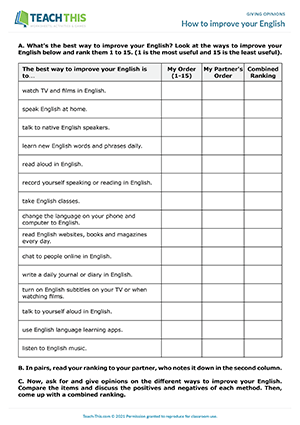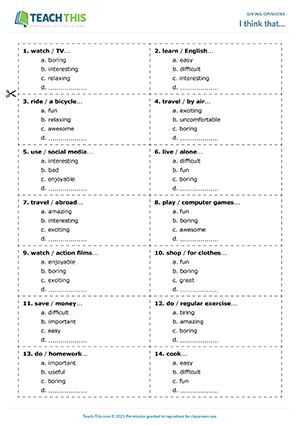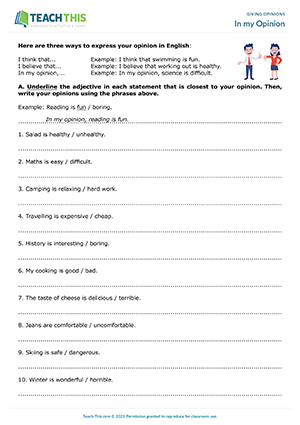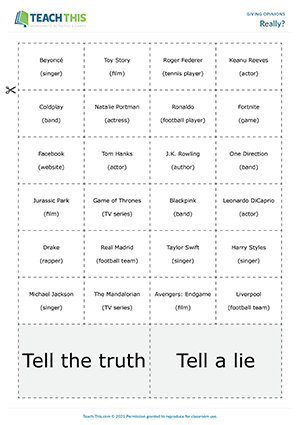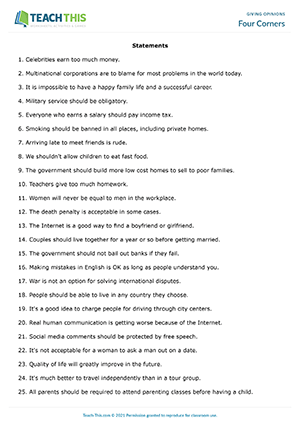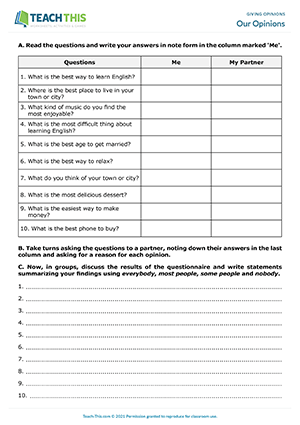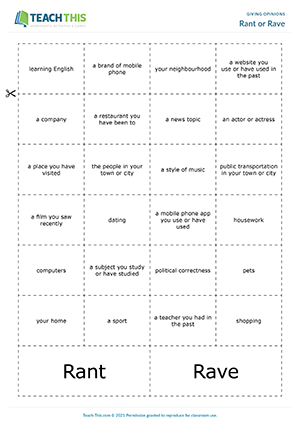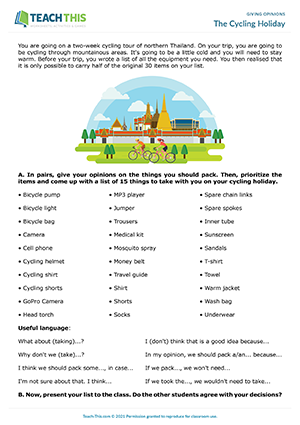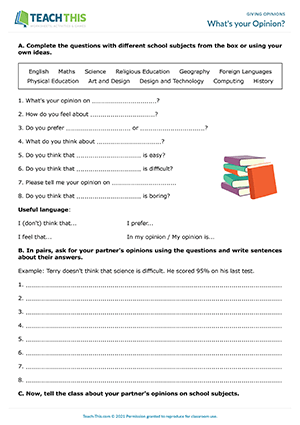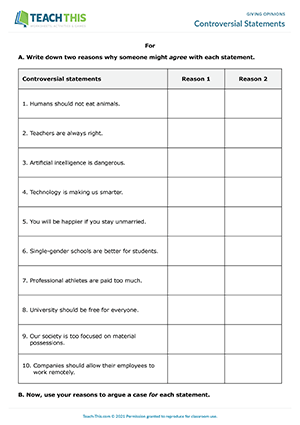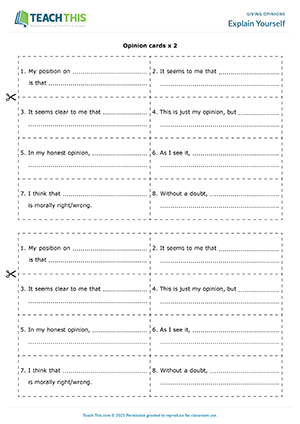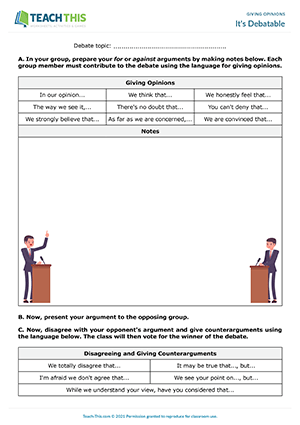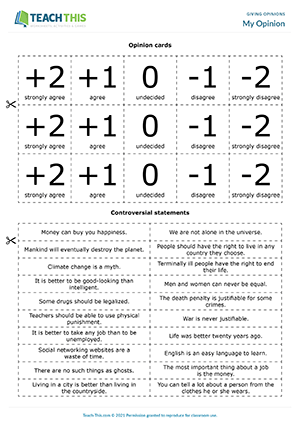In this free giving opinions speaking activity, students ask for and express opinions on ways to improve their English. Working alone, students rank 15 ways to improve their English (1 is the most useful and 15 is the least useful). In pairs, students then read out their ranking to their partner who notes their ranking down. Next, students ask for and give their opinions on the different methods. Students also compare the items, discuss the merits and drawbacks of each method, and come up with a combined ranking. Afterwards, students work with a new partner and compare their combined rankings, discussing any similarities or differences. Finally, students join with their original partner and report back to the class on their top three methods for improving their English.
Here is a communicative opinion sharing speaking activity to help students practice language structures for stating opinions. In pairs, students take it in turns to pick up a card and lay it on the table. Each card shows a topic with four possible opinions, one written by one of the students. The student then gives their opinion about the topic on the card by making a complete sentence from the prompt, e.g. 'I think that watching TV is entertaining'. The other student then gives their opinion. Students also explain the reason for their opinion and ask follow-up questions when possible. This continues until both students have given an opinion for each card.
This comprehensive giving opinions worksheet helps to teach pre-intermediate students how to give basic opinions. Students begin by underlining the adjective in each statement that is closest to their opinion. Students then write their opinion using one of three opinion expressions, e.g. 'In my opinion, reading is fun'. Next, students read how to give an opinion by making the expressions negative to show disagreement. Students then write four things they disagree with from Exercise A using the negative expressions, e.g. 'I don't think that reading is boring'. After that, students read ten statements and write each statement in an 'agree' or 'disagree' column in a chart based on their opinion. In pairs, students then take it in turns to share their opinions with their partner who responds by agreeing or disagreeing. The two students then mark the 'Do you agree with me?' column accordingly.
In this fun giving opinions game, students give true or false opinions about famous people or things. Players take it in turns to pick up a card showing the name of a famous person or thing. The student to their right asks the player for their opinion of the person or thing on the card, e.g. 'What do you think of Lady Gaga?' The player then picks up a 'Tell the truth' or 'Tell a lie' card. If the player picks up a 'Tell the truth' card, they give an honest opinion. If the player has a 'Tell a lie' card, they give an opinion that isn't true. The other students then ask the player one follow-up question each to help them decide if the player is lying or telling the truth, e.g. 'What's your favourite Lady Gaga song?' The other students then collectively decide if the player is lying or telling the truth and the player reveals the answer. If the students guess correctly, they each score one point. If they guess incorrectly, the player scores two points. The student with the most points at the end of the game wins.
In this free giving and defending opinions speaking activity, students practice expressing and defending their opinions. Place a sign in each corner of the classroom (strongly agree, agree, disagree, strongly disagree). Read a statement to the class, e.g. 'Celebrities earn too much money'. Students then go to the corner that best matches their opinion on the topic, e.g. strongly agree. Students in the same corner discuss why they chose that opinion and then report their reasons to the class. After each corner has given reasons for their opinion, students from the different corners politely refute another corner's opinion. Afterwards, students that want to switch to another corner do so. The process is then repeated with a new statement and so on.
In this insightful expressing opinions speaking activity, students practice giving, explaining and summarizing opinions. Students start by reading questions on the worksheet and writing down their answers. In pairs, students then take it in turns to ask the questions to their partner and note down the answers. Students also ask their partner to give a reason for each opinion. After that, pairs join together to make groups of six. In their groups, students discuss the results of the questionnaire and write statements summarizing their findings, e.g. 'Most people think the best way to learn English is to practice it every day'. Finally, groups present their findings to the class.
In this entertaining giving opinions game, students rant and rave about various topics using positive or negative opinion adjectives. In groups, players take it in turns to pick up a topic card and place it face up on the desk for everyone to see. The player then picks up a 'Rant' or 'Rave' card. If the player turns over a 'Rant' card, they express negative opinions about the topic on the card for one minute, without stopping. If the player picks up a 'Rave' card, they express positive opinions. The other students listen and award one point to the player for each appropriate opinion adjective they use during their rant or rave. If a player can't think of anything to say or stops talking before the time limit has been reached, no points are awarded. The player with the most points at the end of the game wins.
In this communicative giving opinions speaking activity, students share opinions, prioritize, and agree on a list of items to pack for a cycling holiday. In pairs, students give their opinions on the things they should pack for their cycling holiday. Students then prioritize the items and come up with a list of 15 things to take with them on their holiday. Afterwards, pairs present their list of items to the class who listen and say whether they agree or disagree with the items chosen, pointing out any problems they see with the list. The presenting pair can then justify their opinions if need be. When all the pairs have presented, the class sees if they can agree on and come up with a list together.
In this enjoyable asking for and giving opinions speaking activity, students ask for and share opinions on school subjects. Students begin by completing each question on the worksheet with a different school subject. In pairs, students then ask their partner the questions on the worksheet and write sentences about their opinions, e.g. 'Terry doesn't think that science is difficult. He scored 95% on his last test'. When the pairs have finished, they check each other's sentences for errors. Finally, students present their partner's opinions to the class.
In this engaging giving and justifying opinions speaking activity, students express and justify opinions by arguing for or against a set of controversial statements. Working alone, students read statements and write down two reasons why someone might agree or disagree with each one. Next, in groups, comprising of two 'for' students and two 'against' students, students discuss the controversial statements, giving and justifying their opinions, and arguing for or against each statement. When the groups have finished, they tell the class who gave the most convincing arguments and why. As an extension, students discuss their real opinions on the controversial statements in their groups.
In this communicative giving opinions speaking activity, students practice giving opinions and asking embedded questions to gain more information. In groups, students take turns choosing a numbered card and a controversial issue from the board. Each student then completes the opinion phrase on that numbered card with their opinion on the topic. Students then mix the opinion cards together. Next, the first student picks up one of the cards and reads the opinion to the group who guesses which student. the card belongs to. The writer then reveals themselves to the group, who then ask the student embedded questions to get them to explain more about their opinion and feelings on the issue. If the students have opposing views on their cards, they have a brief debate on the topic. The next student then chooses a number and controversial issue, and so on. Afterwards, groups give feedback on which topics caused the most debate and who gave the most convincing arguments.
In this free debating activity, students participate in a debate to help them practice expressions for giving opinions, disagreeing and giving counterarguments. In competing groups, students write a debate topic on the worksheet and prepare their for or against arguments. When everyone is ready, two groups debate their topic in front of the class with each group member contributing to the debate. After each group has presented their arguments, the two groups respond to each other by disagreeing and giving counterarguments. Afterwards, the class votes for the winner. Two new groups then come to the front of the class and begin the next debate, and so on.
In this communicative giving opinions activity, students express opinions on controversial statements and try to persuade others with differing opinions to change their minds. In groups, students take turns picking up a statement card and reading it to the group. Next, each student chooses an opinion card to show how much they agree or disagree with the statement and places it in front of them, e.g. strongly agree, undecided, disagree, etc. The reader then gives their opinion and the other students respond with their own opinion in turn. After that, students try to persuade the group members with differing opinions to change their minds. If anyone changes their mind during the discussion, they show this by changing the opinion card in front of them. Afterwards, groups give feedback on which statements caused the greatest argument and say who was the most persuasive..
Latest Free
Resources
- The Bus Stop
Getting Around (B1)
Date Added: 1st of October
- Study Skills Showdown
Study Skills (B2)
Date Added: 10th of September
- Everyday Objects Bingo
Everyday Objects (A1-A2)
Date Added: 25th of August
- Action Verb Races
Actions (A1-A2)
Date Added: 18th of August
- Birthday Basics
Birthdays (A1-A2)
Date Added: 8th of August
Latest Member
Resources
- Casual Greetings
Greetings and Introductions (B2)
Date Added: 22nd of October
- Identifying and Clarifying Problems
Dealing with Problems (B2)
Date Added: 22nd of October
- What if we tried...?
Dealing with Problems (B2)
Date Added: 22nd of October
- Suitable Excuses
Making Excuses (B2)
Date Added: 21st of October
- Superlatives Showdown
Superlatives (A1-A2)
Date Added: 21st of October



